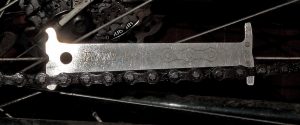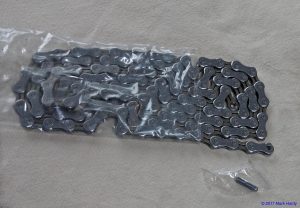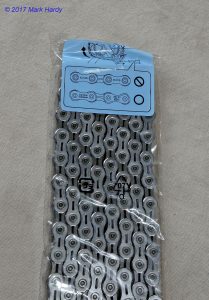The chain is the power transmission link between the chainset and the cassette on the rear wheel. It passes around the chain ring, along to, around and through the two jockey wheel positions, to the bottom of the rear mech onto a sprocket on the cassette, and along toward the chainset again, passing through the two parallel arms of the front derailleur or front mech. It does this on a continuous loop and is nudged and fed laterally onto a larger or smaller sprocket on the cassette by the rear mech, and nudged and fed laterally onto a larger or smaller chain ring on the chainset by the front mech, in both cases whilst the bike is being pedaled. Under load, i.e. when the cycle is being pedaled, the chain is under strong tension between the top of the cassette and the top of the chain ring. At the bottom of its loop between the bottom of the chain ring, through the jockey wheels of the rear mech and onto the cassette, the chain is not under load and is therefore relaxed. This is true for geared cycles as it is for single gear cycles.
Chain construction.
Chain widths vary according to the number of gears on the cassette and width of teeth on the chain ring. Generally, the higher the number of gears (sprockets) on a cassette, the narrower the width of the chain will be.
A cycle chain is a roller chain. It is constructed from inner and outer steel link sections which are nickel coated. The surfaces that come into contact with the teeth of a cassette or chain ring are also teflon coated to reduce wear. The links are alternate male and female sections that fit around a linking pin which passes through a small roller.
When fitting a chain on a cycle the chain is manually fed around the various parts of the group set, and the end male and female links joined via a pin pushed through with a chain splitting tool. Links may be removed using the chain splitting tool prior to inserting the pin to modify the chain length, as the length should be such that the rear mech can move the chain to all sprockets on the cassette without the rear mech in its relaxed position rubbing against a section of chain.
Many of the higher quality chains are directional. This means the chain should be fitted so that one side of the chain faces out, and this is usually identified by the manufacturer’s name or brand visible all along the chain. “Maker’s name facing out” is the term worth remembering on a directional chain. Directional chains are asymmetrically profiled such that gear changes are smoother and more positive. An chain fitted in the wrong direction can result in it slipping off the cassette or chain ring.
On the importance of link distance, wear and TLC.
The chain must be able to withstand strong and sudden changes in stressful forces on a continuous basis, from a standing start to acceleration, then relaxing, then acceleration again. It must also withstand constant bending as the chain rarely runs straight. Lateral shifting at the chain ring and cassette means that for each chain ring there is only one sprocket on the cassette where the chain is running straight and not bending.
Over time, commonly a few thousand miles of cycle use, the chain becomes less effective as it stretches. On a new chain, pin center to pin center is 12.7mm. A chain gauge measures the distance between 11 pins by resting against the inside surface of the roller around pin one and at the other end, against the inside surface of the roller around pin eleven. This distance is 120.7mm. The general rule is if wear and stretch increases this distance on the chain by 1% (1.2mm) the chain needs replacing as it has weakened and can snap under load.

New chain and chain gauge. Note the right hand end of the gauge fits neatly into a link but the left hand end won’t drop in. This shows chain has zero wear.

Old worn chain with chain gauge. Note both ends of gauge slip fully in between links, indicating chain has stretched beyond 1% over the 11 link distance.
It can then be seen that a chain has to withstand constant forces during its useful life as a power transmitter and is therefore one of the most crucial components on a cycle, in that it requires a level of TLC to prolong its life and it does not respond well to neglect. Regular cleaning of a chain is recommended. The build up of dirt on a chain mixes with oil and forms a paste which can accelerate wear and abrasion. A chain that is not adequately oiled can become less effective as the links stiffen reducing free movement. Chains can also rust if left in wet or damp conditions over time. The ideal maintenance of a chain requires habit forming by the rider. After a long ride, the chain should be wiped by running it through a clean cloth. A simple application of only three or four drops of chain oil at interval around the chain is enough to keep it working as it should. Aerosol and penetrating oils are not recommended as chain lubricants. Even though penetrating oils can lubricate and clean a chain by removing some debris and old oil from the links, the reality is that most chains are cleaned and lubricated whilst on the cycle, and aerosol penetrating oils are notoriously good at finding their way onto surfaces and bearings that reduce their effectiveness. Aerosol oil that gets onto brake surfaces, brake discs and pads, wheel bearings and bottom bracket bearings can at best reduce their effectiveness, and at worst, render them inoperable.
Common brands of chain used on factory cycles and as replacement chains are Shimano, Taya, KMC, Oxford, SRAM and Campagnolo.


